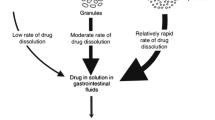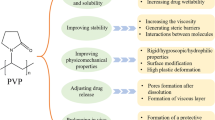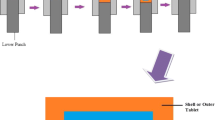Abstract
This study determined the physical, compressional, and binding properties of neem gum (NMG) obtained from the trunk of Azadirachta indica (A Juss) in a paracetamol tablet formulation in comparison with official Acacia gum BP (ACA). The physical and flow properties were evaluated using density parameters: porosity, Carr’s index, Hausner’s ratio, and flow rate. Compressional properties were analyzed using Heckel and Kawakita equations. The tensile strength, brittle fracture index, and crushing strength–friability/disintegration time ratio were used to evaluate the mechanical properties of paracetamol tablets while the drug release properties of the tablets were assessed using disintegration time and dissolution times. Tablet formulations containing NMG exhibited faster onset and higher amount of plastic deformation during compression than those containing ACA. Neem gum produced paracetamol tablets with lower mechanical strength; however, the tendency of the tablets to cap or laminate was lower when compared to those containing ACA. Inclusion of NMG improved the balance between binding and disintegration properties of paracetamol tablets produced than those containing ACA. Neem gum produced paracetamol tablets with lower disintegration and dissolution times than those containing ACA.








Similar content being viewed by others
Abbreviations
- NMG:
-
Neem gum
- ACA:
-
Acacia gum BP
- CSFR/DT:
-
Crushing strength–friability/disintegration time ratio
- BFI:
-
Brittle fracture index
- T:
-
Tensile strength
- DT:
-
Disintegration time
- HR:
-
Hausner’s ratio
- CI:
-
Carr’s index
- FR:
-
Friability
References
Adeagbo AA, Alebiowu G. Evaluation of cocoa butter as potential lubricant for coprocessing in pharmaceutical tablets. Pharm Dev Tech 2008;13:197–204.
Adetogun EA, Alebiowu G. Properties of Delonix regia seed gum as a novel tablet binder. Acta Pol Pharm Drug Res. 2009;66(4):433–8.
Adetogun GE, Alebiowu G. Influence of Delonix regia seed gum on the compressional characteristics of paracetamol tablet formulation. J Drug Del Sci Tech 2007;17(6):443–5.
Akin-Ajani OD, Itiola OA, Odeku OA. Effect of plantain and corn starches on the mechanical and disintegration properties of paracetamol tablets. AAPS Pharm Sci Tech. 2005;6:E458–63.
Alebiowu G, Itiola OA. Compressional characteristics of native and pregelatinized forms of sorghum, plantain and corn starches and the mechanical properties of their tablets. Drug Dev Ind Pharm. 2002;28(6):663–72.
Alebiowu G, Itiola OA. The effects of starches on mechanical properties of paracetamol tablet formulations. I. Pregelatinization of starch binders. Acta Pharm. 2003;53:231–7.
Alebiowu G, Osinoiki KA. Assessment of tapioca starches obtained after different steeping periods as binders in a paracetamol tablet formulation. Farmacia. 2010;58(3):341–52.
Farahmand B, Nikbin K. Predicting fracture and fatigue crack growth properties using tensile properties. Eng Fract Mech. 2008;75:2144–55.
Gangurde AB, Malode SS, Bhambar RS. Preliminary evaluation of neem gum as tablet binder. Indian J Pharm Educ Res. 2008;42(4):344–7.
Hancock BC, Carlson GT, Ladipo DD, Langdon BA, Mullarney MP. The powder flow and compact mechanical properties of two recently developed matrix forming polymers. J Pharm Pharmacol. 2001;53:1193–9.
Heckel RW. Density–pressure relationships in powder compaction. Trans Metall Soc AIME. 1961;221:671–5.
Hiestand EN, Wells JF, Poet CB, Ochs JF. Physical processes of tableting. J Pharm Sci. 1977;66(3):510–9.
Humbert-Droz P, Gurny R, Mordier D, Doelker E. Densification behavior of drugs presenting availability problems. Int J Pharm Technol Prod Manuf. 1983;4:29–35.
Itiola OA, Pilpel N. Formulation effects on the mechanical properties of metronidazole tablets. J Pharm Pharmacol. 1991;43:145–7.
Itiola OA, Pilpel N. Tabletting characteristics of metronidazole formulations. Int J Pharm. 1986;31:99–105.
Joneja SK, Harcum WW, Skinner G, Barnum PE, Guo JH. Investigating the fundamental effects of binders on pharmaceutical tablet performance. Drug Dev Ind Pharm. 1999;25:1129–35.
Kawakita K, Ludde KH. Some considerations in powder compression equations. Powder Technol. 1970/71;4:61–8.
Kitazawa S, Johno I, Ito Y, Teramura S, Okada J. Effects of hardness on the disintegration and dissolution rate of uncoated caffeine tablets. J Pharm Pharmacol. 1975;27:765–70.
Kulkarni AP, Yunus RS, Dehghan MHD. Application of neem gum for aqueous film coating of ciprofloxacin tablets. Int J Appl Res Nat Prod. 2013;6(3):11–9.
Lin C, Cham T. Compression behaviour and tensile strength of heat-treated polyethylene glycols. Int J Pharm. 1995;118:169–79.
Mattsson S, Bredenberg S, Nystrom C. Formulation of high tensile strength rapidly disintegrating tablets—evaluation of the effect of some binder properties. STP Pharma Sci. 2001;11:211–20.
Nayak BR, Rao R, Pattabiraman TN. Studies on plant gums. Isolation and characterisation of the major polysaccharide from neem (Azadirachta indica) gum. Proc Indian Acad Sci B Exp Biol. 1978;87(10):261–9.
Noyes AA, Whitney WR. The rate of solution of solid substances in their own solutions. J Am Chem Soc. 1897;19:930–4.
Odeku OA, Itiola OA. Evaluation of the effects of khaya gum on the mechanical and release properties of paracetamol tablets. Drug Dev Ind Pharm. 2003;29(3):311–20.
Ogunjimi AT, Alebiowu G. A quantitative study of the influence of coprocessing of binders on the mechanical properties of paracetamol tablets. Braz J Pharm Sci. 2010;46(2):205–12.
Ogunjimi AT, Alebiowu G. Flow and consolidation properties of neem gum coprocessed with two pharmaceutical excipients. Powder Technol. 2013;246:187–92.
Ogunjimi AT, Alebiowu G. Material and tableting properties of Azadirachta indica gum with reference to official Acacia gum. Acta. Pol. Pharm. 2014; in press.
Pesonen T, Paronen P. Evaluation of a new cellulose material as a binding agent for the direct compression of tablets. Drug Dev Ind Pharm. 1986;12:2091–111.
Podczeck F, Sharma M. The influence of particle size and shape of components of binary powder mixtures on the maximum volume reduction due to packing. Int J Pharm. 1996;137:41–7.
Prajapati VD, Jani GK, Moradiya NG, Randeria NP. Pharmaceutical applications of various natural gums, mucilages and their modified forms. Carbohydr Polym. 2013;92(2):1685–99.
Upadrashta SM, Katikaneni PR, Nuessle NO. Chitosan as a tablet binder. Drug Dev Ind Pharm. 1992;18(15):1701–8.
Usha LS, Pattabiraman TN. Studies on plant gums. I. Identification of nitrogenous compounds in neem (Azadirachta indica) gum and isolation of d-glucosamine. Indian J Biochem. 1967;4(3):181–3.
Washburn EW. The dynamics of capillary flow. Phys Rev. 1992;17:273–81.
Wu CY, Ruddy O, Bentham AC, Best SM, Elliot JA. Modelling the mechanical behavior of pharmaceutical powders during compaction. Powder Technol. 2005;152:107–17.
Author information
Authors and Affiliations
Corresponding author
Rights and permissions
About this article
Cite this article
Ogunjimi, A.T., Alebiowu, G. Neem Gum as a Binder in a Formulated Paracetamol Tablet with Reference to Acacia Gum BP. AAPS PharmSciTech 15, 500–510 (2014). https://doi.org/10.1208/s12249-014-0079-x
Received:
Accepted:
Published:
Issue Date:
DOI: https://doi.org/10.1208/s12249-014-0079-x




